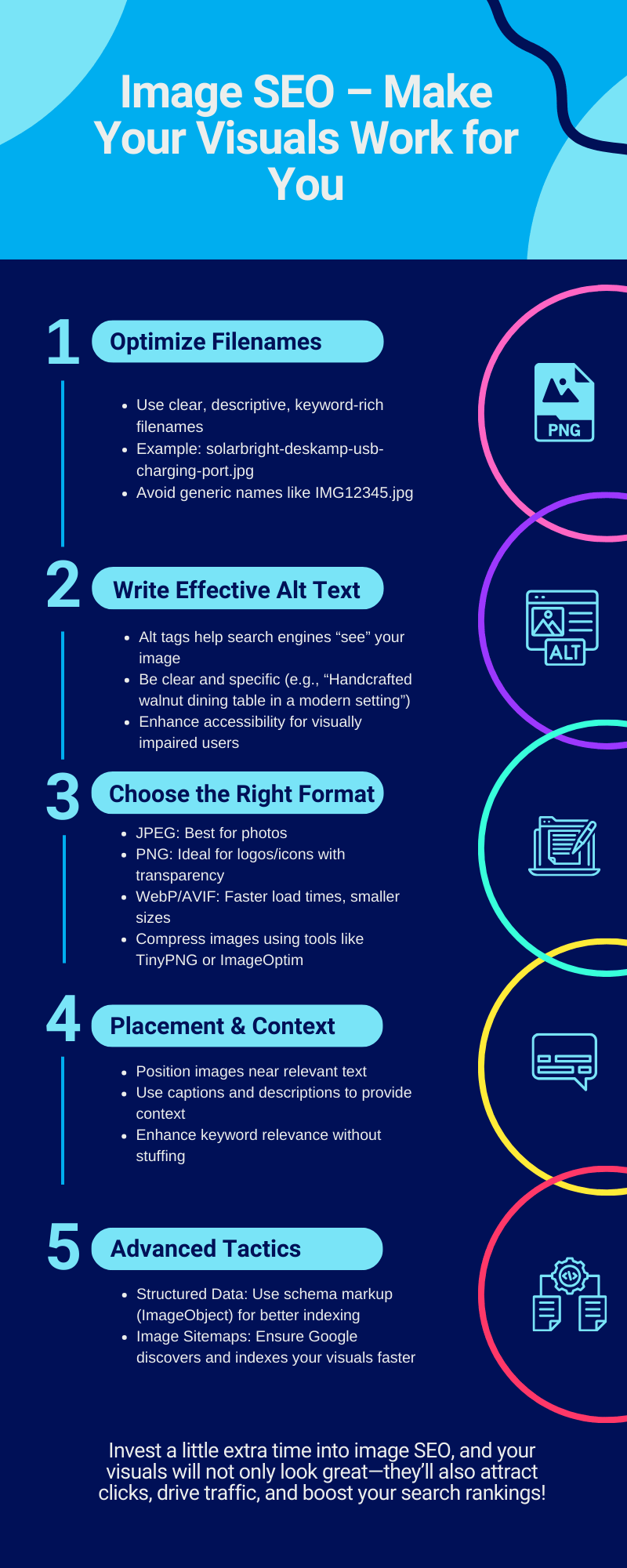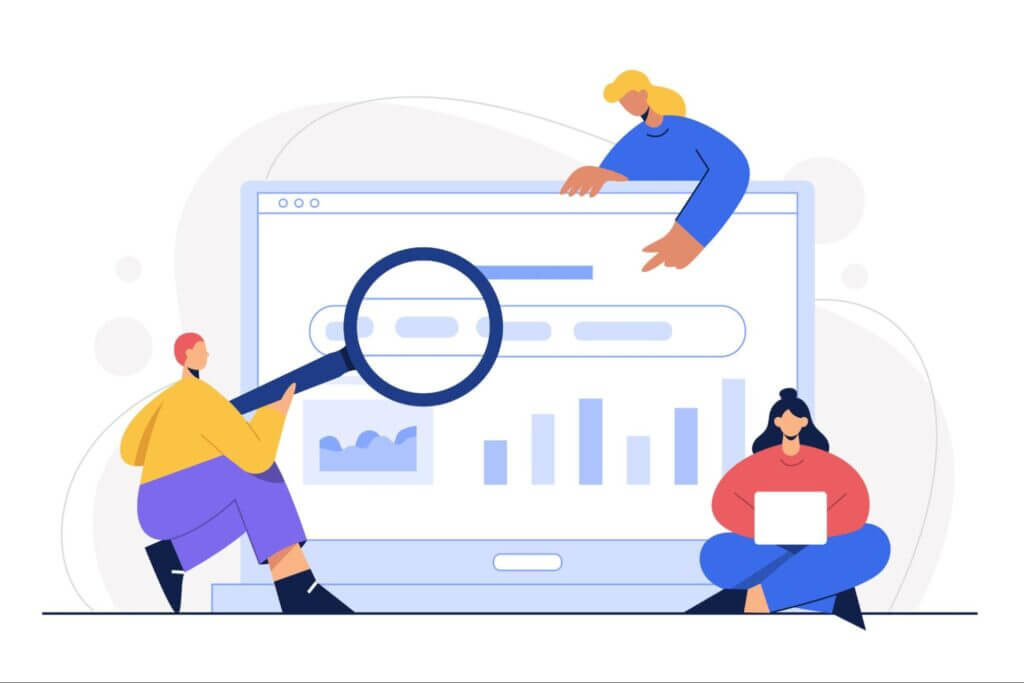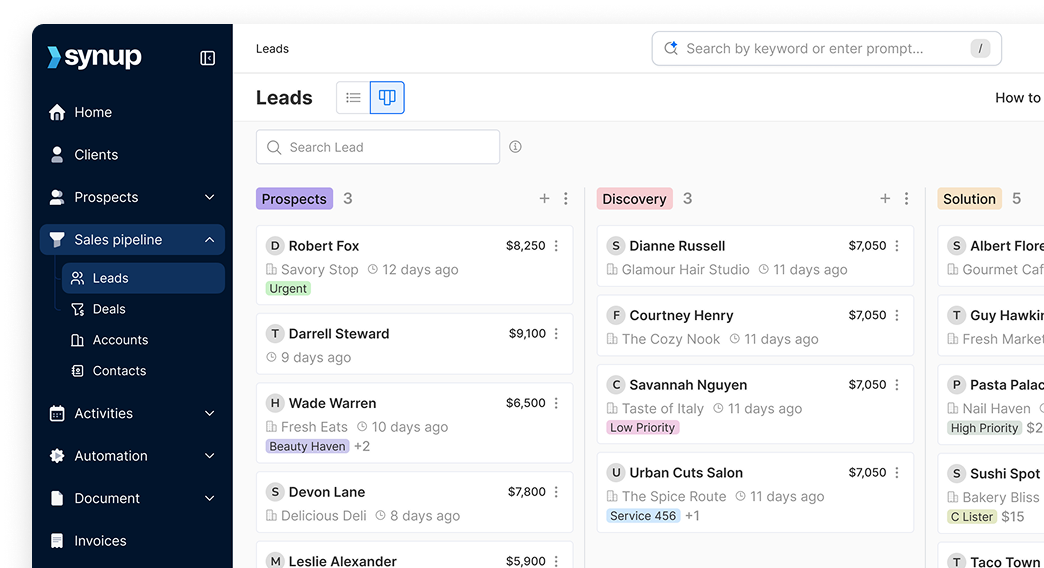Image Search Optimization Guide 2025
Learn how to optimize image file names, alt texts, and sizes for better search visibility. Read on to start optimizing today!

People love pictures. Search engines do too. But if your images aren’t optimized for search, they might as well be invisible, both to searchers and the search engines.
That’s why image SEO is super important for content marketing. It’s not just about pretty pictures; it’s about making them easy to find, fast to load, and relevant to searches. Because let’s be real—when was the last time you scrolled past Google’s first (or second) page looking for an image?
This guide will break down all the step-by-step strategies to make your images search-friendly. From alt text to file names to structured data, we’ll cover it all.
TL;DR: Image Search Optimization Guide
Images can drive traffic, improve search rankings, and boost engagement—but only if they’re optimized.
- Use clear, keyword-rich filenames
- Add alt text
- Choose the right format
- Compress images
- Place images near relevant text
- Use lazy loading
- Submit images to platforms
- Keep images fresh
Bottom line: Search engines reward well-optimized images. Take a few extra steps, and your images will work harder for you. Need an easy way to keep images looking sharp and loading fast? Synup automatically resizes and compresses images for every platform.
Image SEO: Making Your Images Search-Ready
You’ve got great images. But are they optimized for search? If not, they’re just floating in the digital void. Here's how to fix that.
- Use Descriptive Filenames
Let’s be real—IMG12345.jpg tells search engines absolutely nothing. A filename should describe what’s in the image, not look like a WiFi password.
Best practice: solarbright-deskamp-usb-charging-port.jpg
❌ Bad example: photo1.jpg
Filenames are like mini captions for search engines. The more specific, the better. So optimize them everywhere: on the website, social media and even when scheduling your Google business posts.
- Optimize Image Titles and Descriptions
Search engines love details. A great image title and description helps them understand what’s in the image and improves your image search rankings.
Example:
Title: "Modern wooden dining table – eco-friendly, handcrafted design"
Meta description: "Sleek walnut dining table with metal legs, perfect for contemporary and minimalist interiors."
Don’t just stuff in keywords. Write like you’re describing the image to a friend.
- Add Alternative Text (Alt Tags)
Alt text serves two big purposes:
- It helps search engines "see" your image.
- It makes your site more accessible for visually impaired users.
A good alt tag is clear and specific. Here’s what to do (and what not to do):
Good alt text: "Handcrafted walnut dining table with metal legs in a modern home setting."
❌ Bad alt text: "Table for sale."
Imagine explaining the image over the phone: what would you say? That’s your alt text.
Optimizing File Format and Size for Faster Loading
No one likes a slow website. If your images take ages to load, people bounce, search engines notice, and rankings drop. But you can fix this with the right image search optimization techniques.
- Choosing the Right File Format
Different images need different formats.
- JPEG (JPG): Your go-to for photos and general website images. Good quality, small file size.
- PNG: Ideal for logos, icons, and anything needing transparency. Just know—file sizes run larger.
- WebP & AVIF: The new tech. They keep images crisp while shrinking file sizes. Faster loads, better SEO.
Pro tip: If your website supports WebP or AVIF, use them. They make images load up to 35% faster and convert 50% better.
- Compressing Images for Speed & SEO
A huge image file is like packing a suitcase full of bricks. Your website struggles to carry the load. To make your website load images faster, you need to compress them.
Try these free tools:
- TinyPNG: Quick and easy for PNGs and JPEGs.
- ImageOptim: Works offline, great for bulk compression.
- Squoosh: Google’s tool, lets you tweak quality vs. file size.
- Ideal Image Sizes for Web
Right-sizing your images means faster pages and a smoother user experience. Here’s a simple guide:
- Main images: 1200x800px (big but optimized)
- Feature images: 600x600px (clean and balanced)
- Thumbnails: 300x300px (small but mighty)
Keyword Optimization for Image Search
Again, when you want your images to rank on Google, it all starts with keywords. But not just any keywords: long-tail keywords.
Instead of a broad term like “sneakers,” provide something more specific. What would someone actually type when searching? Something like:
"men’s running shoes black Nike Air Zoom"
That’s where Google Image Search and Pinterest Trends come in. They help you discover real searches that people make. Just type a word, scroll through suggestions, and you’ve got keyword ideas to work with.
Pro tip: Look at competitors. If they rank for an image, check their file name, alt text, and description. Learn from what works.
Enhancing Context & Relevance for Visual Search
Search engines don’t just see images; they need context. Proper placement, keyword implementation, captions, and descriptions help images rank higher and attract clicks.
Implementing Keywords in Image Metadata
Now that you’ve got the right keywords, it’s time to put them to work.
Where? Everywhere it matters:
- Image title: Name it clearly. Instead of IMG_1234.jpg, use black-nike-air-zoom-running-shoes.jpg.
- Alt text: Describe it like you’re explaining to a friend who can’t see it. Example: "Black Nike Air Zoom running shoes for men, designed for comfort and speed." But watch it; don't get it beyond 150 characters.
- Captions: If you use captions, integrate the keywords naturally. Don’t force it.
- Structured data: Google loves schema markup. Use ImageObject schema to give search engines more context.

The goal is to help search engines AND humans understand your image. When done right, your images don’t just look good—they rank high and drive clicks. So, name them right, describe them well, and let them work for you.
Placing Images Near Relevant Text
Ever seen a random image floating on a webpage with no explanation? Search engines and people need context. Always place images near relevant text.
If you're selling running shoes, a great product photo alone isn’t enough. Position it beside a detailed description highlighting key features like breathable mesh and cushioned soles.
Likewise, a blog about marathon training shouldn't have an unexplained sneaker image in the middle—it confuses both readers and search engines. Google prioritizes relevant content, so connecting images to text improves visibility and ranking.
Using Captions & Descriptions for Context
Think about the last time you scrolled through a webpage. Did you read every single word? Probably not. But chances are, you read the captions.
Captions stand out. They catch the eye and provide quick context. In fact, studies by Rev show captions increase engagement by 16% because they’re one of the first things people read.
Now, let’s compare two caption styles:
"Handwoven Turkish cotton bath towel – ultra-soft, quick-drying, and perfect for everyday use."
❌ "Bath towel on a table."
The first one gives details. It tells you what’s special about the towel. The second just states the obvious. If someone is searching for a high-quality towel, they won’t find that second one helpful or clickable.
The same rule applies to image descriptions. If you’re selling that towel, don’t just say, "Soft, white towel." Instead, describe it in a way that answers customer questions:
"This ultra-soft Turkish cotton towel absorbs water fast, dries quickly, and gets even softer after every wash. Perfect for home, gym, or travel."
Again, don't forget the 150-character rule.
This approach does two things:
- It helps search engines understand your image, making it likelier for you to appear in image search results.
- It helps customers decide to click, buy, or learn more.
Takeaway: Every image should have context. Whether it’s the placement on the page, the caption, or the description, always give search engines (and people) a reason to care.
Advanced Image Optimization Techniques
Optimizing images isn’t just about making them look good but also about making sure they get found. You could have the most stunning product photos or high-quality visuals, but if search engines don’t understand them, they won’t show up where they should.
Advanced techniques like structured data markup and image sitemaps aren’t just technical add-ons; they’re essential for ranking higher in image search and driving more organic traffic.
Google’s algorithm is like a librarian. If you give your images clear labels, descriptions, and an organized filing system, they’re easier to find. If not, they might get lost in the digital backroom, never making it to the search results.
Let’s break down two key ways to help search engines understand and index your images faster and more accurately.
Structured Data Markup (Schema.org for Images)
Search engines see images, but they don’t automatically know what they’re about. They rely on context—and structured data is one of the best ways to provide it.
Schema markup is like a nutrition label for your images. It spells out exactly what’s in the image, making it easier for Google to match it to relevant searches. This means better rankings, higher visibility, and more clicks.
Let’s say you’re selling a modern wooden dining table. Instead of hoping Google figures it out from the page content, you can tell it directly using Schema.org’s ImageObject markup. Here's what it looks like:
{
"@context": "https://schema.org",
"@type": "ImageObject",
"name": "Modern Wooden Dining Table",
"contentUrl": "https://www.example.com/images/dining-table.jpg",
"description": "Handcrafted walnut dining table with metal legs in a modern home setting."
}
This simple snippet helps Google connect the dots, making it more likely your image will appear in Google Images, rich results, and even featured snippets.
And here’s the kicker: structured data doesn’t only improve search rankings, it can boost click-through rates too. When users see rich image previews with descriptions, they’re more likely to engage.
If you run an e-commerce store, a local business, or any site with images that need visibility, structured data can change the content marketing game for you.
Using Image Sitemaps for Better Indexing
Ever uploaded an image, waited, and then realized Google never indexed it? It happens more than you’d think. Just go through your website's backend.
Search engines prioritize text first, which means your images might be overlooked or crawled slowly. That’s where image sitemaps come in. They tell Google:
- Where to find your images
- What each image is about
- Why they’re important for your content
Adding images to your XML sitemap helps them get discovered faster and improves their ranking potential. Here’s what an optimized image sitemap entry looks like:
<image:image>
<image:loc>https://www.example.com/images/dining-table.jpg</image:loc>
<image:title>Modern Wooden Dining Table</image:title>
<image:caption>Handcrafted walnut dining table with metal legs.</image:caption>
</image:image>
Why does this matter? Because images drive traffic! Studies show that the Google Image Search results box appears in over 30% of all web searches, according to Search Engine Land. That’s a huge opportunity to attract potential customers.
If your site is image-heavy—think online stores, real estate listings, travel blogs, or photography portfolios—image sitemaps are crucial. Without them, Google might miss some of your best visuals.
How to Implement Image Sitemaps
- Include all important images: Product photos, infographics, blog images—anything you want Google to find.
- Add descriptive titles & captions: Just like Schema markup, context helps. A generic “image1.jpg” won’t cut it.
- Submit your sitemap in Google Search Console: This tells Google, “Hey, these images are important!” and speeds up indexing.
Performance & Engagement Optimization
Images can make or break a website’s user experience. A well-placed image grabs attention, tells a story, and makes content more engaging. But if those same images slow down your site or don’t get shared, they can hurt more than help.
Think about it. Have you ever clicked on a website, waited for it to load… and then just left? According to Google, 53% of mobile users abandon their efforts on a site if it takes longer than 3 seconds to load. And images are often the biggest culprits behind slow speeds because they're heavier than text.
But it’s not just about speed. If your images aren’t being shared, linked to, or updated, they’re not doing much for your SEO. That’s why performance and engagement optimization are critical. Let’s break down three ways to keep your images fast, relevant, and shareable.
Website Speed & Lazy Loading
We live in a fast-scrolling world. People want content immediately, and they won’t wait around for slow-loading images. That’s why lazy loading is one of the smartest things you can do for your website.
What is Lazy Loading?
Lazy loading is a simple trick that delays loading images until they’re needed. Instead of making a user’s browser load every image on the page at once (which can slow things down), lazy loading only loads images when they come into view.
It's like scrolling through Instagram. You don’t download every post before you even open the app; it loads as you scroll. That’s lazy loading in action.
Why Does This Matter?
- Pages load faster, reducing bounce rates.
- Better SEO, since Google favors fast websites.
- Smoother user experience, especially for mobile users.
What Else Helps?
- Use Progressive JPEGs: Instead of loading an image all at once, progressive JPEGs load in layers. Users see a blurry version first, which sharpens as it loads.
- Optimize image sizes: Compress images before uploading using tools like TinyPNG or ImageOptim.
- Use next-gen formats: Google recommends WebP, which offers better compression than JPEG and PNG without losing quality.
Backlinks & Image Sharing
If you’re only using images on your own website, you’re leaving a huge SEO opportunity on the table.
Images can drive traffic from other platforms, but only if shared and linked. That’s why image backlinks are so valuable. The more places your images appear (with proper attribution), the more authority and visibility your website gets.
Where to Submit Your Images
- Pinterest: A well-optimized Pin can drive traffic for years. Use keywords in descriptions, add alt text, and link back to your site.
- Google My Business: For local businesses, regularly updating your Google My Business profile with images can boost local search rankings and attract customers.
- Industry Blogs & Publications: Offer high-quality images to relevant websites in your industry. In return, they’ll credit and link back to your site.
How to Build Backlinks with Images
- Create unique, high-quality visuals: Infographics, charts, and custom graphics get shared more than generic stock photos.
- Watermark or brand your images: This ensures people know where they came from, even if they get shared elsewhere.
- Encourage sharing: Add social sharing buttons and include calls to action like, “Pin this for later!”
Search engines love backlinks, and images can be a great way to earn them organically.
Keeping Content Fresh
If your site uses the same old, outdated visuals, it might lose its search relevance over time. Just like updating blog posts and product descriptions, keeping your images fresh helps maintain rankings.
How to Keep Images Fresh
- Upload new product photos regularly: If you run an e-commerce site, update images when you get new stock or variations.
- Refresh blog post visuals: Swap out old images for higher-quality or more relevant ones.
- Use seasonal images: If you’re in fashion, food, or travel, updating images to match current trends keeps content relevant.
- Test new image formats: Experiment with WebP, GIFs, and interactive images to see what resonates with your audience.
Google rewards active sites, and refreshing your visuals is an easy way to show that your site is up to date. Customers appreciate it, too. No one wants to see a website stuck in 2015.
Also Read: Effective Local Listing Management Strategies to Maximize Online Visibility
Summing Up
Images are more than just pretty visuals—they’re powerful SEO assets. However, they might not reach their full potential without the right alt text, positioning, page loading techniques, structured data, and image sitemaps.
If you think your images are slowing down your site, not getting shared, or going stale, they’re not doing their job.
To fix that:
- Employ lazy loading to speed up load times.
- Submit images to platforms that drive backlinks and traffic.
- Keep images fresh to stay relevant in search.
The bottom line is to make it easy for search engines to comprehend your images, and they’ll reward you with better rankings. Add alt text, structured data, and image sitemaps, and suddenly, your images will go from invisible to impossible to ignore.
Optimizing images is just a single piece of the content marketing puzzle. You must have a strong online presence on several platforms if you want to stand out. Synup helps businesses manage their digital footprint, ensuring their images, listings, and brand messaging stays consistent, visible, and optimized for search. Want to make sure your business gets found, engages customers, and drives action? See how Synup helps.
Optimize Images for Search: FAQs
How do I optimize an image for search?
Keep it simple. Name your file something clear (not “IMG_1234”), add alt text with real keywords, and compress the image so it loads fast. Google also loves context, so place images near relevant text instead of randomly dropping them on the page.
Which image format is best for SEO?
In most cases, JPEG is the best for the web. It keeps quality high, but file sizes small, which helps pages load faster. PNG works great if you need a transparent background, but it’s heavier. If you want next-level compression, try WebP—Google loves it, and it makes images load even faster.
What image size should I use for SEO?
It depends on where it’s going! A Facebook preview? 1200 x 630 pixels. An Instagram post? 1080 x 1080 pixels. For websites, resize images so they fit their display area without slowing down load times. Bigger isn’t always better—faster is.




